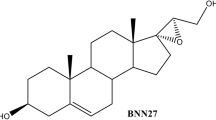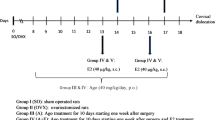Summary
In this work, we studied the possible estrogenic modulation of the effects of δ9-tetrahydrocannabinol (THC) on mesolimbic dopaminergic activity, by examining the effects of an acute dose of this cannabinoid: (i) during the estrous cycle; (ii) after ovariectomy, chronic estrogen-replacement and tamoxifen (TMX)-induced blockade of estrogenic receptors; and (iii) combined with a single and physiological injection of estradiol to ovariectomized rats. THC significantly decreased the density of D1 dopaminergic receptors and non-significantly increased the L-3,4-dihydroxyphenylacetic acid (DOPAC) content in the limbic forebrain of ovariectomized rats chronically replaced with estrogens. The decrease in D1 receptors was also produced by TMX, whereas the coadministration of both THC and TMX did not lead to a major decrease. In addition to the trend of THC increasing DOPAC content, this cannabinoid was also able to increase the ratio between DOPAC and dopamine, although this last effect only occurred after coadministration of THC and TMX, which had been ineffective administered individually. All these effects were not seen when THC was administered to normal cycling rats during each phase of estrous cycle and to ovariectomized rats without chronic estrogen replacement or only submitted to a single and acute dose of estradiol. This observation might be related to the fact that the density of limbic cannabinoid receptors increased in chronic estrogen-replaced ovariectomized ratsversus normal cycling, ovariectomized or acutely estrogen-treated ovariectomized rats. Interestingly, THC administration in ovariectomized rats was followed by a slight, although significant, increase in tyrosine hydroxylase activity, which was also observed after coadministration of THC with a short-time and acute dose of estradiol. In summary, THC stimulated the presynaptic activity of mesolimbic dopaminergic neurons, but accompanied by a decrease in their postsynaptic sensitivity. These effects did not appear in normal cycling rats being only evident after ovariectomy and chronic estrogen replacement, which might be related to changes in binding characteristics of cannabinoid receptors in this area. Moreover, some of them appeared after TMX-induced blockade of estrogenic cytosolic receptors, which likely suggests the existence of a certain estrogenic modulation of the actions of THC on mesolimbic neurons. On the contrary, coadministration of THC with a single and shortly tested dose of estradiol was always ineffective in modifying THC effects.
Similar content being viewed by others
References
Bonnin A, Fernández-Ruiz JJ, Martín M, Rodríguez de Fonseca F, de Miguel R, Ramos JA (1992) Estrogenic modulation of δ9-tetrahydrocannabinol effects on nigrostriatal dopaminergic activity in the female rat brain. Mol Cell Neurosci 3: 315–325
Bowers MB, Hoffman FJ (1986) Regional homovanillic acid following δ9-tetrahydrocannabinol and cocaine. Brain Res 366: 405–408
Bridgen T, Fan F, Compton DR, Martin BR (1990) Competitive inhibition of cannabinoid binding in a novel filtration assay. FASEB J A 996: 4240
Cebeira M, Hernández ML, Rodríguez de Fonseca F, de Miguel R, Fernández-Ruiz JJ, Ramos JA (1991) Lack of effect of prolactin on the dopaminergic receptor sensitivity in striatal and limbic areas after experimentally-induced alterations in its peripheral levels. Life Sci 48: 531–541
Chakravarty I, Sengupta D, Bhattacharya P, Ghosh JJ (1975) Effect of treatment with cannabis extract on the water and glycogen content of the uterus in normal and estradiol-treated rats. Toxicol Appl Pharmacol 34: 513–516
Chen J, Paredes W, Li J, Smith D, Lowinson J, Gardner EL (1990) δ9-Tetrahydrocannabinol produces naloxone-blockable enhancement of presynaptic basal dopamine efflux in nucleus accumbens of conscious, freely-moving rats as measured by intracerebral microdialysis. Psychopharmacology 102: 156–162
Dalterio S, Steger RW, Mayfield D, Bartke A (1984) Early cannabinoid exposure influences neuroendocrine and reproductive functions in male mice. II. Postnatal effects. Pharmacol Biochem Behav 20: 115–121
Devane WA, Dysarz III FA, Johnson MR, Melvin LS, Howlett AC (1988) Determination and characterization of a cannabinoid receptor in rat brain. Mol Pharmacol 34: 605–613
Dewey WL (1986) Cannabinoid pharmacology. Pharmacol Rev 38: 151–178
Di Paolo T, Rouillard C, Bedard P (1985) 17β-estradiol at a physiological dose acutely increases dopamine turnover in rat brain. Eur J Pharmacol 117: 197–203
Eldridge JC, Landfield PW (1990) Cannabinoid interactions with glucocorticoid receptors in rat hippocampus. Brain Res 534: 135–141
Fernández-Ruiz JJ, Alvarez-Sanz C, Ramos JA (1989) 2-Hydroxyestradiol is not mediating the effects of estradiol on tuberoinfundibular dopaminergic neurons controlling prolactin secretion in female rats. J Steroid Biochem 32: 71–75
Fernández-Ruiz JJ, de Miguel R, Hernández ML, Ramos JA (1990) Time-course of the effects of ovarian steroids on the activity of limbic and striatal dopaminergic neurons in female rat brain. Pharmacol Biochem Behav 36: 603–606
Fernández-Ruiz JJ, Rodríguez de Fonseca F, Navarro M, Ramos JA (1992) Maternal cannabinoid exposure and brain development: changes in the ontogeny of dopaminergic neurons. In: Bartke A, Murphy LL (eds) Marihuana cannabinoids: neurobiology and neurophysiology. Biochemistry and physiology of substance abuse, vol IV. CRC Press, Boca Raton, pp 119–164
Gardner EL, Paredes W, Smith D, Donner A, Milling C, Cohen D, Morrison D (1988) Facilitation of brain stimulation reward by δ9-tetrahydrocannabinol. Psychopharmacology 96: 142–148
Glowinski J, Iversen LL (1966) Catecholamine regional metabolism in rat brain. J Neurochem 13: 655–669
Gordon JH, Bromley BL, Gorski RA, Zimmermann E (1978) δ9-Tetrahydrocannabinol enhancement of lordosis behavior in estrogen treated female rats. Pharmacol Biochem Behav 8: 603–608
Herkenham M, Lynn AB, Little MD, Johnson MR, Melvin LS, de Costa BR, Rice KC (1990) Cannabinoid receptor localization in brain. PNAS (USA) 87: 1932–1938
Houston DB, Evans DM, Howlett AC, Melvin LS (1991) [3H]-CP-55,940 binding to the cannabinoid receptor. Du Pont Biotech Update 6: 21–27
Howlett AC, Bidaut-Russell M, Devane WA, Melvin LS, Johnson MR, Herkenham M (1990) The cannabinoid receptor: biochemical, anatomical, and behavioral characterization. TINS 13: 420–423
Leipheimer RE, Bona-Gallo A, Gallo RV (1986) Influence of estradiol and progesterone on pulsatile LH secretion in 8-day ovariectomized rats. Neuroendocrinology 43: 300–307
Lowry OH, Rosebrough NJ, Farr AL, Randall RJ (1951) Protein measurement with the folin phenol reagent. J Biol Chem 193: 265–275
Maggi A, Pérez J (1985) Role of female gonadal hormones in the central nervous system: clinical and experimental aspects. Life Sci 37: 906–912
McEwen BS (1987) Steroid hormones and brain development: some guidelines for under-standing actions of pseudohormones and other toxic agents. Environ Health Perspect 74: 177–184
McEwen BS, Parsons B (1982) Gonadal steroid action on the brain: neurochemistry and neuropharmacology. Ann Rev Pharmacol Toxicol 22: 555–598
Murphy LL, Rodríguez de Fonseca F, Steger RW (1991) δ9-Tetrahydrocannabinol antagonism of the anterior pituitary response to estradiol in immature female rats. Steroids 56: 97–102
Nagatsu T, Oka K, Kato T (1979) Highly sensitive assay for tyrosine hydroxylase activity by high performance liquid chromatography. J Chromatogr 163: 247–252
Okey AB, Bondy GP (1977) Is δ9-tetrahydrocannabinol estrogenic? Science 195: 904–906
Okey AB, Bondy GP (1978) δ9-Tetrahydrocannabinol and 17β-estradiol bind to different macromolecules in estrogen target tissues. Science 200: 312–314
Purohit VD, Ahluwahlia BS, Vigersky RA (1980) Marihuana inhibits dihydrotestosterone binding to the androgen receptor. Endocrinology 107: 848–850
Rawithch AB, Schultz GS, Kurt EE (1977) Competition of δ9-tetrahydrocannabinol with estrogens in rat uterine estrogen receptor binding. Science 197: 1189–1191
Reader TA, Briere R, Gottberg E, Diop L, Grondin L (1988) Specific [3H]SCH 23390 binding to dopamine D1 receptors in central cortex and neostriatum: evidence for heterogeneities in affinity states and cortical distribution. J Neurochem 50: 451–463
Rodríguez de Fonseca F, Cebeira M, Hernández ML, Ramos JA, Fernández-Ruiz JJ (1990) Changes in brain dopaminergic indices induced by perinatal exposure to cannabinoids in rats. Dev Brain Res 51: 237–240
Rodríguez de Fonseca F, Cebeira M, Fernández-Ruiz JJ, Navarro M, Ramos JA (1991) Effects of pre- and perinatal exposure to hashish extracts on the ontogeny of brain dopaminergic neurons. Neuroscience 43: 713–723
Rodríguez de Fonseca F, Hernández ML, de Miguel R, Fernández-Ruiz JJ, Ramos JA (1992 a) Early changes in the development of dopaminergic neurotransmission after maternal exposure to cannabinoids. Pharmacol Biochem Behav 41: 469–474
Rodríguez de Fonseca F, Fernández-Ruiz JJ, Murphy LL, Cebeira M, Steger RW, Bartke A, Ramos JA (1992 b) Acute effects of δ9-tetrahydrocannabinol on dopaminergic activity in several rat brain areas. Pharmacol Biochem Behav 42: 269–275
Rodríguez de Fonseca F, Cebeira M, Ramos JA, Martin M, Fernández-Ruiz JJ (1992c) Cannabinoid binding sites in rat brain areas: sexual differences, fluctuations during the estrous cycle and changes after gonadectomy and sex steroid replacement. Life Sci (in press)
Solomon J, Cocchia MA, DiMartino R (1977) The effects of δ9-tetrahydrocannabinol on uterine and vaginal cytology. Science 195: 875–879
Author information
Authors and Affiliations
Additional information
Presented in abstract form to the Third IBRO World Congress of Neuroscience, Montreal (Canada), August 4–9, 1991
Rights and permissions
About this article
Cite this article
Bonnin, A., Fernández-Ruiz, J.J., Martín, M. et al. δ9-Tetrahydrocannabinol affects mesolimbic dopaminergic activity in the female rat brain: interactions with estrogens. J. Neural Transmission 92, 81–95 (1993). https://doi.org/10.1007/BF01244868
Received:
Accepted:
Issue Date:
DOI: https://doi.org/10.1007/BF01244868




